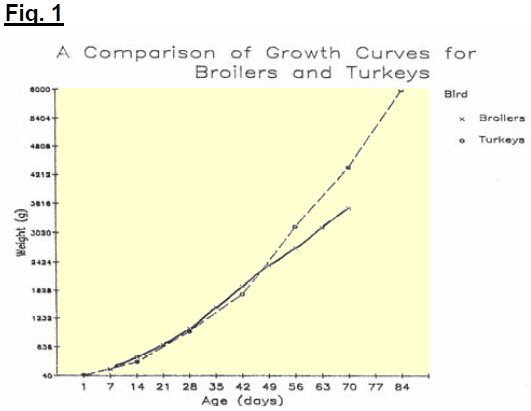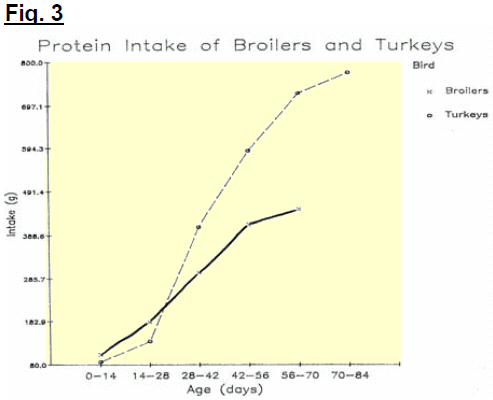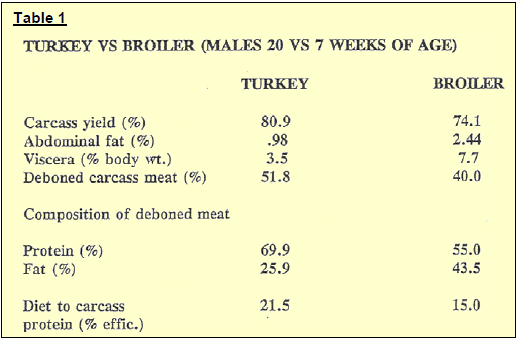



Heavy Turkeys - Are they Being Properly Fed?
Technical Information bulletin 4 from the Canadian Poultry Industry Council. John D. Summers compares the growth of heavy turkeys and chickens, and uses this to emphasise the importance of appropriate feeding for both growing and breeding birds.The heavy, fast growing turkey is relatively a “Newcomer”, as far as classical meat production animals. Much of the input into nutrient requirements and feeding programs has been extrapolated from research done with chickens. While it is true that many research reports have appeared regarding nutrient requirements and feeding programs for turkeys, there have been few basic studies on nutrient requirements.
A search of the literature quickly reveals that the amount of nutrition research done with turkeys is significantly less than a decade or so ago. This is surprising in light of the rapid growth now achieved and the increased demand for white meat, an area where the turkey excels, as compared to the chicken.
It is interesting to stop and make a few comparisons with the turkey and the broiler chicken with respect to the growth rate, carcass composition and efficiency of protein utilization. In Fig. 1 is shown the growth curves for male broilers and turkeys to 70 and 84 days respectively. It can be noted that up to around 6 weeks of age broilers are heavier than turkeys. The reason for this is undoubtedly due to the marked increase in early feed intake of the broiler as compared to the turkey (Fig. 2). This probably reflects the selection for early growth rate of the broiler as compared to the turkey. It is of interest to look at protein intake for the turkey versus the broiler to around 4 to 5 weeks of age (Fig. 3).



If one looks at carcass protein yield (Fig. 4) it can be seen that the broiler, up to around 8 weeks of age, is depositing more protein in its carcass than the turkey. However, from the data shown in Fig. 3 it is obvious that the turkey is consuming more protein beyond 5 weeks of age than the broiler.

It is not uncommon for turkey producers to complain about wet litter up to 12 to 14 weeks of age. Could this be due to an excess intake of protein in relation to requirements? It is well known that high protein intakes result in wet litter due to higher water consumption to excrete the high levels of uric acid produced.
At market age if one compares the 7 week old broiler male with the 20 week old male turkey then a much different picture is noted with respect to the efficiency of the turkey versus the chicken broiler as a meat producing animal. There is a 5 to 6% higher carcass yield for the turkey and this carcass contains significantly less fat and a higher yield of edible meat than does the broiler carcass (Table 1).

Also the composition of the de-boned carcass meat for the turkey is significantly higher in protein and lower in fat than that of the chicken broiler (Table 1). This results in an overall efficiency of dietary protein for the turkey.
The large increase in breast muscle for the turkey, which is relatively high in protein compared to other portions of the carcass, at a time when dietary protein levels have been reduced to around 14%, obviously helps to account for the better utilization of dietary protein by the market turkey as compared to the broiler.
It should be pointed out that during the last half of the growing period often very dry and dusty conditions are noted in the turkey pen. This might well be explained, in part, by the lower level of dietary protein fed at this time being closer to the actual requirement of the turkey (as compared to the early growing period) and thus much less water is consumed to get rid of excess uric acid production.
The turkey, being a much larger animal throughout most of its life span than the broiler, obviously diverts a much larger proportion of its feed intake to maintenance than does the broiler. A recent article by Dr. Steve Leeson of the University of Guelph makes an interesting comparison between the Leghorn hen and the turkey hen with respect to nutrient requirements for egg production versus body maintenance.
Table 2 compares the performance of the turkey breeder hen with that of the Leghorn. Interestingly both produce similar egg mass at peak production. However, calculation of dietary energy and protein intakes and utilization indicates a quite different partition in end use of these nutrients (Table 3 & 4).


While the turkey breeder hen and the Leghorn produce similar daily egg mass at peak, the percentage of nutrient intake used for egg production is much less for the turkey. From Table 3 & 4 it is estimated that the turkey breeder utilizes just 11% of its energy intake and 23% of its protein intake for egg production at peak production. On the other hand, the Leghorn uses 31 and 50% respectively for the same comparison. Thus the turkey uses around 80% of its protein and energy intake to meet its requirements for maintenance, while the Leghorn uses only around 41% (Table 3).
This being the case in commercial practice, body weight and environmental conditions are the main factors influencing the nutrient requirements of the turkey hen and these needs overwhelm those needed for reproductive purposes. However, for the Leghorn, body weight and environmental temperatures would be much less of a factor influencing its nutrient requirements.
A similar situation would also be noted for the broiler chicken versus the heavy weight mature turkey. As the turkey matures the demand for nutrients for growth purposes would gradually be reduced, as a percent of nutrient intake, while the demand for nutrients for body maintenance would increase. Hence, nutrient requirements for the heavy turkey as it approaches market age, is largely for maintenance plus activity. Such a condition would not be true for the smaller weight chicken broiler.
Thus perhaps it is time to re-think the approach to ration formulation for the heavy turkey and produce diets that more closely consider maintenance versus the requirements for growth.
It is interesting that Dr. Leeson in his article calculated the amino acid requirements of the turkey breeder based on data generated to predict essential amino acids required for egg production and maintenance. These predicted needs, converted to dietary specifications are shown in Table 5 and compared to nutrient levels found in a typical turkey breeder diet.

It would appear that crude protein is significantly higher in commercial diets than may be required (12 vs. 17%). Also, the cystine requirement is markedly underestimated with commercial formulations (0.61 vs. 0.24). The deficiency of cystine is obviously less important when one considers total sulphur amino acids. However, a deficiency of sulphur amino acid still exists.
Unfortunately, in today’s environment of cut backs in poultry education and research at Canadian institutions, there is little or no research being done in the feeding of turkeys. For a country that is one of the world leaders in turkey meat production and consumption, per capita, this is a disturbing situation. There is a tremendous potential to utilize the genetic potential of the turkey to produce high quality lean meat, at reasonable costs. It is hoped that those in the industry and academic institutions are encouraged to increase research efforts so Canada can remain at the fore in turkey production technology and hence production.








